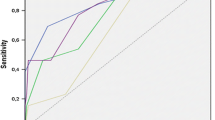Abstract
A dual-energy X-ray absorptiometry (DXA) machine was used to measure the bone mineral density (BMD) of both femora in 760 female volunteers. Each volunteer completed a questionnaire and exclusion criteria were applied such that only 480 of these were considered normal subjects. The remaining 280 women failed to comply with the criteria and were considered ‘abnormal’; their BMD results were analysed separately. Two abnormal subgroups, one with previous long bone fractures and one with radiologically diagnosed osteopenia, were studied. BMD values for femoral neck, Ward's triangle and trochanter were compared between the two femora in all the above groups. No dominance relationship was found when comparing left to right femur, averaged over any population studied, but large differences were found between the femora in individual volunteers. There was a high correlation between BMD in opposing femora of 0.91, 0.91 and 0.84 for the femoral neck, Ward's triangle and trochanter respectively. However, in normal subjects the percentage variation in these regions ranged up to 34%, 64% and 80% respectively at the different femoral sites. In addition, the normal population was divided into two subgroups, one in which the density difference between the femora was large, and the other in which the difference was statistically insignificant. The analytical and anatomical variations between these two groups were investigated. Only part of the difference appeared to be due to analytical problems and it seems that there is a genuine difference in femoral density. Poor correlation for femoral neck percentage density difference was found with average BMD, age, height and weight in the normal population. This study concludes that a measurement of BMD in one femur can not reliably predict the BMD in the contralateral femur. It is therefore recommended that routine density measurements should include scanning of both femora.
Similar content being viewed by others
References
Cummings S, Black D. Should perimenopausal women be screened for osteoporosis? Ann Intern Med 1986;104:817–23.
Mazees R, Barden HS, Ettinger M, Schultz E. Bone density of the radius, spine and proximial femur in osteoporosis. J Bone Miner Res 1988;3:13–18.
Need AG, Nordin BEC. Which bone to measure? Osteoporosis Int 1991;1:3–6.
Lessig HJ, Meltzer MS, Siegel JA. The symmetry of the hip bone mineral density: a dual photon absorptiometry approach. Radiology 1988;167:151–3.
Balseiro J, Fahey FH, Ziessman HA, Le TV. Comparison of BMD in both hips. Clin Nuc Med 1987;12(10):811–12.
Hall ML, Heavens J, Ell PJ. Variation between femurs measured by dual energy X-ray absorptiometry (DEXA). Eur J Nucl Med 1991;18:38–40.
Lilley J, Walters BG, Heath DA, Drolc Z. In vivo and in vitro precision for bone density measured by dual energy X-ray absorption. Osteoporosis Int 1991;1:141–6.
Author information
Authors and Affiliations
Rights and permissions
About this article
Cite this article
Lilley, J., Walters, B.G., Heath, D.A. et al. Comparison and investigation of bone mineral density in opposing femora by dual-energy X-ray absorptiometry. Osteoporosis Int 2, 274–278 (1992). https://doi.org/10.1007/BF01623182
Received:
Accepted:
Issue Date:
DOI: https://doi.org/10.1007/BF01623182




